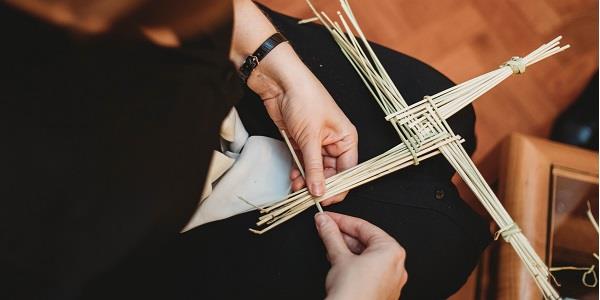
St Brides Castle dominates the beautiful part of Pembrokeshire in which it sits. It would probably dominate the eponymous village too – if there were much of a village there to dominate. As it is, there are a couple of cottages overlooking St Brides Haven Beach, a tiny, stony inlet where children love to go rock-pooling; and a small but interesting parish church, dedicated to St Bridget.

Or should that be St Bride? The two are one and the same. But who was she? Learn more about her by reading our ST Brigid facts and biography.
Saint Brigid of Kildare biography
The story of St Bride (or ST Brigit, Saint Brigid of Kildare or, in Welsh, Ffraid) is one shrouded in folklore, but as far as one can determine, she was an Irish nun who went on to become a petron saint of Ireland.
If one accepts that St Bride was a real person – about which there is some doubt – she was born out of wedlock in around 453 in Dundalk, Ireland. Her father, Dubthach, was a chieftain of the province of Leinster; her mother, Brocca, was a Christian (baptised by St Patrick himself), and his slave. The illegitimate Brigid and her mother were given away to a druid, but evidence of Brigid’s ‘otherness’ showed itself early on: peculiar dietary requirements, miracles, and, after her return to Dubthach as an indentured servant, an infuriating habit of giving away her parents’ possessions in order to feed the poor. This tendency drove Dubthach to distraction; but the King of Leinster recognised Brigid’s holiness, and persuaded Dubthach to give the girl her freedom.
Brigid, as expected, entered a convent; but it was her later action in founding both a convent and a monastery in Kildare that led to her sainthood, and enduring renown.
Brigid was ahead of her time. She saw no distinction between male and female followers of the religious life. She was a friend of St Patrick, and invited (male) hermit Conláed – later St Conleth – to help her run her two institutions. In other words, she espoused gender equality. As enlightened as she was emancipated, Brigid’s Kildare became a centre of both faith and learning, and subsequently a cathedral city.
Brigid’s teachings, her message and her life story chimed with other Celtic communities across the Irish Sea. Irish missionaries to Britain took her message with them, and found a ready audience; there are many St Bride’s churches in Scotland, all dedicated to her.
Brigid, however, never made it out of Ireland.
Or did she?
Just as there are Scottish texts attesting to an apparent visit from the saint, so there is evidence that Brigid did indeed spend time in Pembrokeshire – as a novice, to learn the rules of life in a convent, before heading back to Ireland, and glory.
There is even (questionable) evidence that she made landfall in St Brides Bay itself (though of course it wouldn’t have been called that); and perhaps even alighted at St Brides Haven Beach.
Whatever. As with the Scots, one assumes that the locals in South Wales figured that here was a girl cut from an altogether different cloth. Or perhaps they watched from afar as her star ascended, and later attempted to claim some kind of kinship by naming churches after her.
But then or subsequently, she made an impression: churches dedicated to her, and families taking her name.
Holidaymakers visiting St Brides Castle might note the ruins of a small and much older building: known as the Abbey, and thought to have been the 15th-Century home of one John de St Bride, whose family built the parish church that now stands at St Brides Haven, looking out – or back – across the Irish Sea.

FAQs
What does St Brigid's Cross mean?
St Brigid's Cross is a handmade cross consisting of a square centre and four points, usually made from straw, rushes or reeds woven together and then tied with string. It's common for the materials to have been blessed before use, but they are also often sprinkled with holy water once complete. It's common to see recently crafted crosses appearing above doorways, in posters and as decorations across Ireland on the 1st of February (St Brigid's Day).
While mainly an Irish Christian symbol, the roots of the cross could be traced back to the pagan sunwheel. The main role of St Brigid's Cross is to protect the building where it's displayed and keep away hunger, fire and evil.
Who are the 3 patron saints of Ireland?
Ireland's three patron saints are Saint Patrick, Saint Brigid and Saint Columba.
Why do we celebrate St Brigid's day?
St Brigid's day originates from the Celtic festical of Imbolc, a festility festival which marked the beginning of spring in Ireland – a theme of hope and new beginnings which still hold true today St Brigid's day is celebrated across Ireland every February 1st, when families make crosses, bring them to be blessed and then hang them in their homes for the rest of the year.

